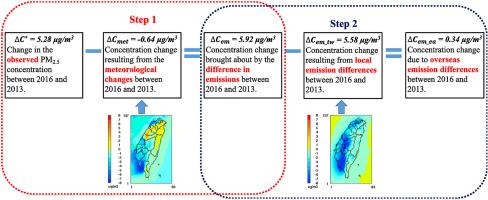Atmospheric Environment ( IF 5 ) Pub Date : 2021-07-07 , DOI: 10.1016/j.atmosenv.2021.118610 Tu-Fu Chen , Ken-Hui Chang , Wen-Ya Liu , Yi-Chi Chen

|
Whether the improvement or deterioration of PM2.5 concentration is caused by a reduction/increase of emissions or a change in the weather has always been a curious yet difficult question to clarify because there are many uncertainties in the simulation system. In previous research, the observed concentration was introduced to reduce the uncertainty of the simulation system; however, no literature existed on how to correctly and reasonably split the observed concentration difference into its contribution from emission changes and its impact from meteorological changes. This study not only derived the splitting process in detail, but further derived the formula for splitting the contribution from emission changes into its contribution from local emission changes and its contribution from overseas emission changes. This was done to assess the importance of changes in Taiwan's own emissions and changes in overseas emissions with regard to the improvement/deterioration of the observed concentration. Based on the derived formula, this study simulated 7 cases and combined the observation data to quantify the emission and meteorological impact on PM2.5 concentrations in Taiwan. Compared to 2013, the results in 2016 show a 5.28 μg/m3 improvement in the observed concentration of PM2.5 in Taiwan, and this was mainly due to the concentration improvement (5.92 μg/m3) brought about by the difference in emissions between those two years; the meteorological difference between those two years may have led to a slight increase in concentration (0.64 μg/m3). Regarding the concentration improvement brought about by the difference in emissions between those two years, 94% resulted from Taiwan's own emission changes, and the remaining 6% resulted from overseas emission changes. These results confirm that the improvement of Taiwan's PM2.5 concentration between those two years should mainly be attributed to Taiwan's own emission reduction. Therefore, the proportion of Taiwan's PM2.5 concentration affected by long-range transport was higher in 2016 (43%) than it was in 2013 (38%).



























 京公网安备 11010802027423号
京公网安备 11010802027423号